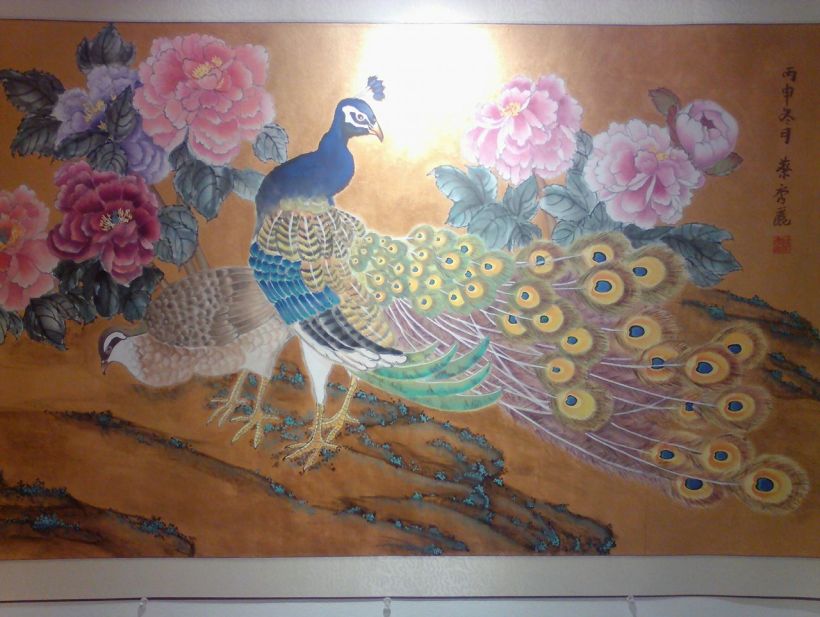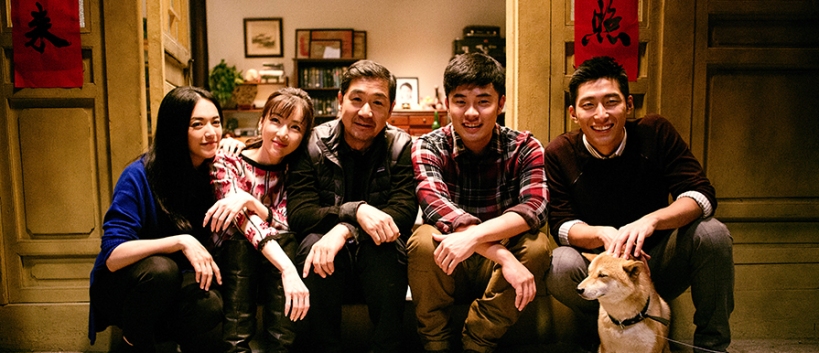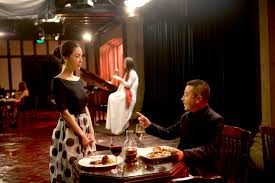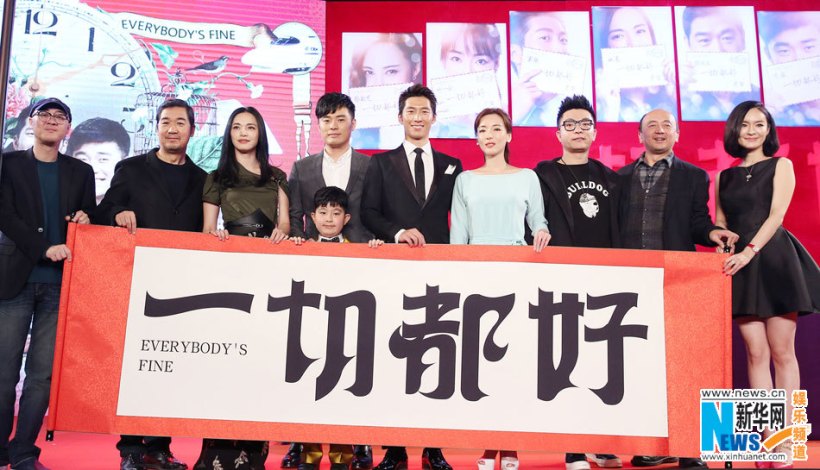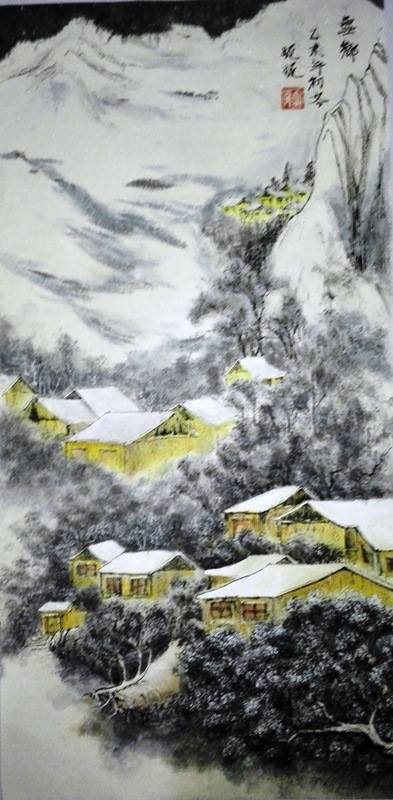Traditional Chinese Painting: A Firm Pillar of Chinese History
Sevilla, Micah S.
February 7, 2017
Cascading into gallery walls which hung lovely frames and sophisticated fans brimming with Chinese virtuosity and oriental philosophies made a nostalgic sweep creep up on my spine; as if the vintage-looking, nature-inspired sights of gray, misty mountains, vigorous little birds perching on tall bamboo shoots, blurred, snowy village landscapes, youthful pop of hydrangea flowers, fresh pink peonies, dancing yellow tulips, cozy chickens cooped up in a barn, poised cocks standing straight as an arrow atop a rock, and highly-animated roosters, were taking me to a trip down memory lane that made me fantasize in an instant; as if I was standing at the imperial court of the Song Dynasty, dressed up in a red, highly-embellished Chinese kimono, completely basking in all of China’s rich cultural heritage.
For some strange reason, there was automatically an unspoken “oriental” connection dawning on me as I gaze at the painting gallery from a fair distance, an unspeakable affirmation that tells me that the exhibit was wholly Chinese, without any foreign parentage involved. In any setting and in any format, Chinese art is always highly-distinctive compared to other cultural arts, even in comparison with its close-knitted, chinky-eyed brothers from the East Asia, such as Korea and Japan. A unique, ethereal charm of the incomparable Chinese antiquity beholds the array of paintings, and made them affluent to each other. That sense of antiquity imbibed me as I feast on the multi-themed exhibit, reminiscing the past I can’t concretely picture on my mind, yet my heart and soul feels something that deeply resonates within me. Painting appreciation is definitely a navigation of one’s very soul, an emotional and spiritual connection that reveals the inner thoughts and deep-seated values of man. Certainly, I’m neither a Chinese nor a painter; but simply allowing myself to get lost in the painters’ intricate artworks gave me a saturating peace that assured me of my belongingness to the oriental culture. To me, this is definitely part of the Chinese skeleton that deserves to be celebrated every Chinese New Year, a long-enduring art form that knows no alienation to race or nationality.
Shangri-La Plaza’s Grand Atrium was momentarily a haven of divinity and repose, atleast for a week- as painting enthusiasts from Ateneo de Manila University’s Confucius Institute show off their most-prized paintings in various styles, frames and sizes from January 25-31, in response to the Chinese tradition of displaying artworks only on special occasions, such as the Chinese New Year festivity. The painters, who were all well-advanced in age, study traditional Chinese painting under the mentorship of Master Painter Caesar Cheng, a connoisseur of painting and calligraphy for over four decades by now. Given that the painters involved were pretty much preoccupied with their marketing and business ventures, most of them only get to the exhibit on its last day during the mall’s closing hours, when all they have to do is pull out their paintings from the gallery and prepare to store their craft at home.
As scion to precision and creativity, the Chinese culture is not only world-renowned for their ink and wash paintings, but also a pioneer in poetry and calligraphy, pushing forth their culture to a natural inclination to the visual arts. As a matter of fact, every traditional Chinese is raised to train in the arts at a very young age, with parents weaning their children to be competitive in both performing arts and visual arts, such as playing instruments and doing calligraphy.
Dating back to the 1st century A.D, the introduction of Buddhism to China led to the popularity of painting religious murals related to Buddhist principles, with themes expanding to a variety of subjects beyond religion only until the Song dynasty. Chinese painting has turned into a firm pillar of culture in China since then, evolving from an imperial hobby to being a serious form of art that knowns no color, race and status, a long-treasured form of art that has preserved the uniqueness of the Chinese culture alongside calligraphy and poetry. Traditional Chinese painting truly mirrors the deeply-rooted values and cardinal principles of the Chinese culture, such as the high regards for nature, a strong connection to the past, and the eight auspicious symbols of Buddhism, including the lotus flower, flower vase and fish pair- ideals that were clearly-evident in the painting exhibit.
The magnificent display of the oriental paintings effortlessly whisked me away from the rest of the crowd, as if the mystic images were talking to me and unraveling their stories before my very eyes. And just like that, the marveling suddenly takes off. There seems to be an unquenchable thirst welling within me, as if I was dead-tired from a long, exhausting journey, parched from thirst and is in dire need of a spring to drink from. I paused there, wondering how to shake hands with the gifted hands that brought forth all these paintings. The next thing I knew, I wanted to sit down with them and watch them pour out the content of their souls and the beauty of their minds to know what led to their works of art. And before I could even walk to the next set of paintings, I saw myself slumped at the fact that I was slowly baring my true self right there and then. I am a frustrated painter.
Despite the dominant use of religio-auspicious symbols and nature-inspired imagery in traditional Chinese painting, painter and entrepreneur Helen Tansuk, maker of “Dancing tulips” and “Lotus” paintings, clarifies that oriental art is a far cry from symbolism, which centers on intellectual examination and logical reasoning, rather than capturing the very essence of the subject. The imagery of animated roosters, cooped up birds, spongy hydrangea flowers, blissful peonies, cozy, cuddly chickens, and gray, misty mountains that took center-stage at the exhibit were captured not only to depict the outer appearance of the subjects but their inner essence as well- the energy, life force, and spirit.
As in-depth conversations with Grace Dadufalza, Necita Cheng, and Helen Tansuk, the experienced and skilful artists of the exhibit, continue to flourish, I was ushered to a deeper understanding of the painting craft from a Chinese’s perspective. The distinctive painting popularized by the Chinese is rather a form of expressionism, notably rich in sensuous values that far outweigh the technical innuendo. As a two-time witness of the week-long exhibit, I came to realize that as well, where the painters have enormously asserted themselves of what wells up in their soul- and perfectly translates everything to a brush.The Chinese canon of aesthetics is fixed on a paradigm that opens spiritual consciousness rather than intellectual expansion, one that is infused with imagination and soul, a sense of craftsmanship that captures the essential spirit and beauty of a scene. But what truly sets Chinese paintings apart from any other painting from the rest of the world is its ability to display magnificence and mystic meanings while exuding pure humility.
Contrary to its Western counterpart, traditional Chinese paintings are humble in nature, a striking beauty that doesn’t necessarily confide in the exact sharpness of details and outlines of the composition observed, but clamors to to contemplate on its sentimentality and intimation. The power to keep you grounded while affixed on majestic imageries is the missing component in European paintings. If we were to closely observe the perfectly crafted Leonardo Da Vinci Paintings and highly-acclaimed visual masterpieces of Michael Angelo and Raphael Sanzio, we’ll end up mouthing vivid praises on how they have made such epitome of perfection, which at times becomes an exaggeration of reality that almost rivals nature, to which Chinese painting completely detracts from. China’s humble paintings suggest a natural flow of dialogue with the past through the most natural style of capturing images, while European paintings cater realist and surrealist paintings like a richly-covered photograph that seems scientifically-right in every angle.
Grace Dadufalza, a 2nd-time participant to Shangri-La’s annual Chinese painting exhibit, says that a deep connection between the materials used in Chinese painting is a key ingredient in fostering artistic forms and techniques. “As for the painters of the exhibit, we used Ling Nan style, which makes use of watercolour rice paper, different kind of brushes and Chinese ink. Ling Nan is way too different from acrylic and oil painting,” Dadufalza reveals.
In Chinese painting, a wide array of Chinese brushes are required for dealing with various subjects and for creating variations in line thickness, as Dadufalza stresses that brush techniques are so much emphasized in Chinese painting not only in line drawing but also in shading and texture, as well as the meticulous dotting methods frequently used to differentiate trees and plants. Brush strokes undeniably give the painting rhythm and beauty while revealing the individuality and style of the painter himself; from the faintest swipe of ink to the boldest, blackest lines, a painter is sure to implicate something to the observer. Some common types of Chinese brush include crab claw brush, rabbit’s hair brush and sheep’s hair brush.
“The tricky thing about Chinese painting is that you can only do the strokes once, can’t put it all over again,” Dadufalza warns. This harsh reality makes Chinese painting a particularly demanding art-form which requires years of training and discipline.
Most of the painters in the exhibit used the literati style or the expressionistic approach to their paintings, using brushstrokes and styling meant for personal creativity. A few of them, on the other hand, are extremely precise and much more decorative with their paintings, incorporating the Chinese gong-bi style, which is coined as the meticulous style of painting in China. Prancing around the artistic walls of the exhibit resound a variety of mood shifts as well, as each painting comes in a variety of styles and hues. Some paintings are in grayish monochrome, others resemble a black and white sketch, while a few of them are very brightly coloured. Each stop takes me on a completely new feeling; each turn gives me a new storyline to engross myself with. By opting for the best dominating color of a painting, the painter immediately articulates the message he wants to come across.
A definite feast for the eyes, my inner self is starting to respond to the sensuality and spirituality of the sophisticated paintings, making me highly-intrigued by the painters’ motivation to come up with such artworks. While different people may have their own personal bias to any painting, one truth remains outstanding- a set of clearly defined symbols lurking behind a painting is key to unlocking the implicit riddle it poses. And of course, as a trademark to Chinese paintings, a variety of subject matter should be carefully considered to decode its meaning, including a rich variety of flowers, fruits, insects, fish and mountains, that depict something significant to the Chinese superstitions and culture. For this specific painting exhibit, it has been noticeable that the painters have particular favourites, such as plum blossoms, bamboo, fishes, lotus and rooster, being used frequently.
Bamboo, one of the most dominant themes in the exhibit, connotes durability, strength, resilience, longevity and vitality; plum blossom stands for renewal and purity; lotus depicts purity and the throne of Buddha; peony is the ‘king of the flowers’ and a symbol of royalty, wealth and virtue; and rose symbolizes youth and the four seasons. As for the animals used in the paintings, crane, fishes, birds and rooster were mostly incorporated. The crane symbolizes longevity and high status in the imperial hierarchy; the fish symbolizes abundance and affluence, as well as marriage and birth of many children; birds symbolize good fortune and opportunities; while the rooster, which is considered lucky in Feng Shui this year, depicts blessings and prosperity. The peacock, which was only used once in the painting exhibit, was the central character to Liezel Ong’s vividly-colored painting, an imagery that symbolizes dignity and beauty. On the other hand, paintings depicting mouth-watering landscapes and portraits of melancholic mountains such as that of Necita Cheng’s also commanded great attention, as mountains possess the symbolic role of being divine.
Besides the humble approach to artistry and the distinctive painting styles and techniques, another remarkable characteristic of Chinese paintings is the added spice of inscriptions and seals that gives a touch of uniqueness and identity to the painting, where the artist’s name and his poetic insights are placed in the artist’s most preferred part of the painting, as a final touch. A painting purposed to be given to a family or friend can also be reinterpreted by the recipient through another set of calligraphy and poetic insights he would like to put into the painting- any strong feeling or immediate connection he has with the painting written in lyric poetry. And as the painting is passed on from each generation to another, the beauty of painting reinterpretation starts to roll, and a historical thread is therefore established.
Above all, Chinese painting requires a life-long commitment to purity of heart and peace of the soul, a central theme to the long-standing Chinese heirloom that is anchored on an old Chinese adage that shames ill-purposed and hypocritical artistry, “No evil man can make a work of art.”

